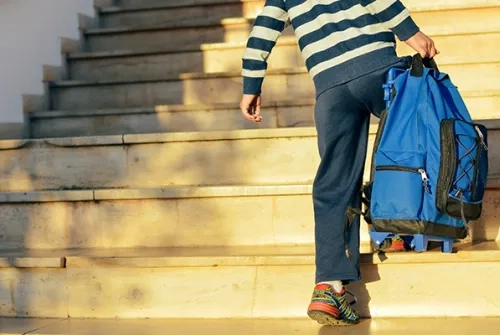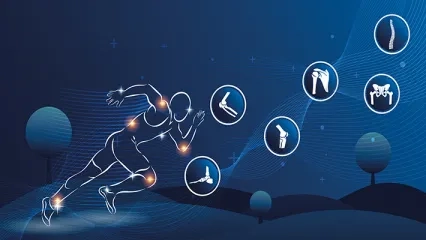Alo Yeditepe
Alo Yeditepe
Heavy School Bags Can Cause Pain in the Lower Back, Shoulders, and Hands!
Orthopedics and Traumatology specialist Prof. Dr. Gökhan Meriç said that carrying a school bag that is 10-15 percent heavier than the child's body weight causes pain in the lower back, shoulders, and hands, and pointed out that a specialist should be consulted for children with long-term back and neck pain despite the measures taken.
During the school year, children have to carry many educational materials in their bags. Moreover, if there are after-school sports activities or courses; books, sports equipment, shoes, and musical instruments to be included in these activities can cause the weight of school bags to increase even more. This can lead to some problems. Stating that back pain in children should not be ignored if it is related to heavy school bags, Yeditepe University Hospitals Orthopedics and Traumatology Specialist Prof. Dr. Gökhan Meriç pointed out that the weight of the bag can cause various disorders in the spine.
"A 30 Kg Child Should Carry a Maximum Weight of 5.5 Kg"
Yeditepe University Kozyatağı Hospital Orthopedics and Traumatology specialist Prof. Dr. Gökhan Meriç stated that carrying a school bag that weighs more than 10-15 percent of the child's body weight has been shown by research to cause pain in the lower back, shoulders, and hands, gave the following information on the subject: "In other words, the maximum bag weight that a 30 kg child should carry should not exceed 5.5 kg. Due to the use of heavy bags, children lean forward to balance these weights, and this can cause deformities called kyphosis in the back and lordosis in the lumbar region. Pain in the shoulders due to the pressure of the heavy bag and numbness in the hands due to the compression of the straps can be seen. Heavy school bags can cause back, neck, and shoulder pain, chronic fatigue, and muscle spasms. This can lead to the child's reluctance to go to school and chronic pain."
What is the Ideal School Bag?
Prof. Dr. Gökhan Meriç said that children should prefer functional and lightweight ones rather than brand and shape when choosing a school bag and explained how the ideal school bag should be as follows: "The backpack should be made of as light material as possible so as not to contribute to the total weight of the bag, and the straps should be thick, and the thick part should be adjustable to coincide with the shoulder. This supports shoulder loading. The height at which the backpack ends should not exceed 10 cm below the child's waist. The straps of the backpack should be evenly spaced and should be at the same level on both shoulders. Generally, families may prefer bags with wheels so that children do not carry heavy bags but a school bag with wheels is heavier than one without wheels and handles. If the child does not need to climb stairs or carry their bag for any reason, wheeled school bags may be a viable choice. If there is a situation where the child needs to climb several floors, then a wheeled bag should not be preferred in these cases as it will create an extra burden."
"Bag Should Not Be Carried on One Shoulder"
Yeditepe University Kozyatağı Hospital Orthopedics and Traumatology specialist Prof. Dr. Gökhan Meriç reminded that one of the mistakes children make when using school bags is to carry the bag with one shoulder and said, "Carrying the bag on one shoulder may cause more load in this area and more strain on the side where it is carried. To prevent this, bags should be carried with both shoulder straps. In addition, the compartments in the bag should be used effectively and heavier books or materials should be placed closer to the back so that the weight is distributed and a balanced bag is created. While children are carrying the bag, the bag should be as close to the back as possible without leaning forward or backward and the back smoothness should be maintained."
Prof. Dr. Gökhan Meriç pointed out that it would also be beneficial for parents to teach children to take out their bags and wait in situations such as waiting for the school bus or bus, and continued his words as follows: "Organizing the books daily will help to remove the books that will not be used that day and reduce the weight of the bag. In addition, heavy books can be placed near the back of the bag to ensure that the weight is carried close to the body. Despite these measures, a specialist should be consulted for long-term shoulder, back, and lower back pain in children."
This content was prepared by Yeditepe University Hospitals Medical Editorial Board.
”
See Also
- Robotic Hip Replacement Surgery
- Knuckle Cracking Can Be Dangerous When It Becomes a Habit!
- What is Hallux Rigidus (Stiff Big Toe/Toe Arthritis)? Symptoms and Treatment
- What is Hallux Valgus (Bunion)? How is it Treated?
- Meniscus and Cartilage Transplantation Can Be Done at the Same Time
- Ergonomics in Automobiles Prevents Accidents
- Joint Pain and Causes of Joint Pain
- Walking and Returning to Social Life After Knee Replacement Surgery
- Robotic Knee Prosthesis Surgery
- Patients Who Undergo Joint Replacement Surgery Can Stand Up and Walk the Next Day
- Big Toes Can Be A Big Problem!
- What is Synovitis in Joints?
- Hip Impingement Syndrome
- What is the Future of Treating Cartilage Problems?
- Not Only Athletes Suffer from Meniscus Tears!
- Is Cartilage Damage More Common in Those Who Run for Long Periods?
- Beware If Your Shoulder Or Neck Pain Lasts Longer Than Two Days After Swimming!
- Mistakes While Swimming Can Cause Shoulder Pain
- Myths About Fractures
- Vitamin D Deficiency May Be The Cause Of Your Joint Pain
- Have Your Baby Take Their First Steps in Good Health
- Sports Injuries
- Cartilage Transplantation from Donor Has Been Started to Perform in Turkey
- Working From Home Increases Waist and Neck Problems
- First Cartilage Transplant from a Donor
- Pay Attention to the Pain That Occurs in the Front Part of Your Knees While Playing Sports!
- Young Patient Who Could Not Walk Due to Cartilage Damage Recovered With Cartilage Transplantation
- Knee Arthritis
- Knee Pain
- Crunching in the Kneecap May Be a Sign of Calcification
- Injured Athletes Can Return To Sports With Cartilage Transplant
Alo Yeditepe


